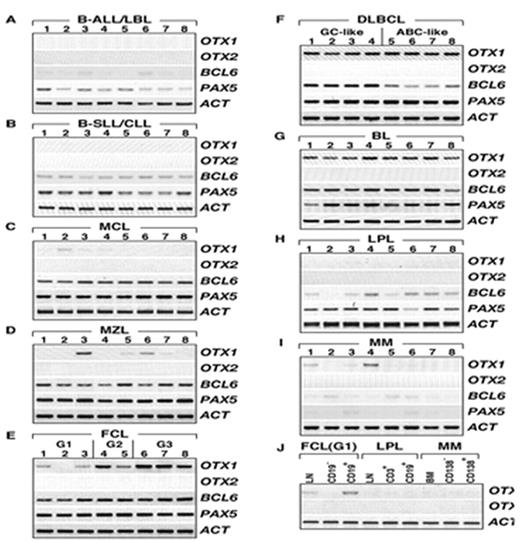Abstract
OTX1 and OTX2 are transcription factors containing a bicoid-like homeodomain and play crucial roles in brain development and in few other body districts as in the case of OTX1, which is required in hematopoiesis for development of the erythroid compartment. Previous studies indicated that in human OTX2 is functionally involved in the generation of anaplastic medulloblastomas; OTX1 expression strongly correlates with nodular/desmoplastic medulloblastomas; and none of them is expressed in other brain tumors. Here we have investigated whether OTX1 and/or OTX2 may potentially be involved in tumors of nonneural origin by focusing on human B-cell non-Hodgkin’s lymphomas (NHLs). We analyzed 184 cases (fig 1)encompassing different NHL subtypes according to the World Health Organization classification and discovered that, while OTX2 expression was never detected, OTX1 was selectively activated in virtually all cases of Diffuse Large B Cell Lymphoma, Burkitt Lymphoma and a relevant fraction of Follicular Cell Lymphomas. In DLBCL lymph nodes and tissue infiltrations, OTX1 protein was detected in the nucleus of PAX5+-CD20+ cancer cells. Conversely, in nonmalignant lymph nodes and tonsils, OTX1 was expressed in a numerically very small and non-proliferating cell population restricted to the germinal center. These OTX1+ cells were CD138+-IgG+, about 50% of them also co-expressed both CD10 and CD20 and none of them exhibited PAX5 or BCL6 expression, thus suggesting that OTX1 expression identifies a subset of GC-restricted plasmacell-like cells (fig 2). Interestingly, in contrast with lymphomas, in these cells the OTX1 protein was prevalently localized to the cytoplasm. Collectively, our data suggest that activation of OTX1 expression and its nuclear localization represent together a newly described molecular event occurring in specific NHL subtypes of GC and early post-GC origin (FCL, DLBCL, BL), and lead us to hypothesize that it may be potentially involved (directly or indirectly) in the initiation and/or maintenance of these tumors.
Author notes
Disclosure: No relevant conflicts of interest to declare.



This feature is available to Subscribers Only
Sign In or Create an Account Close Modal